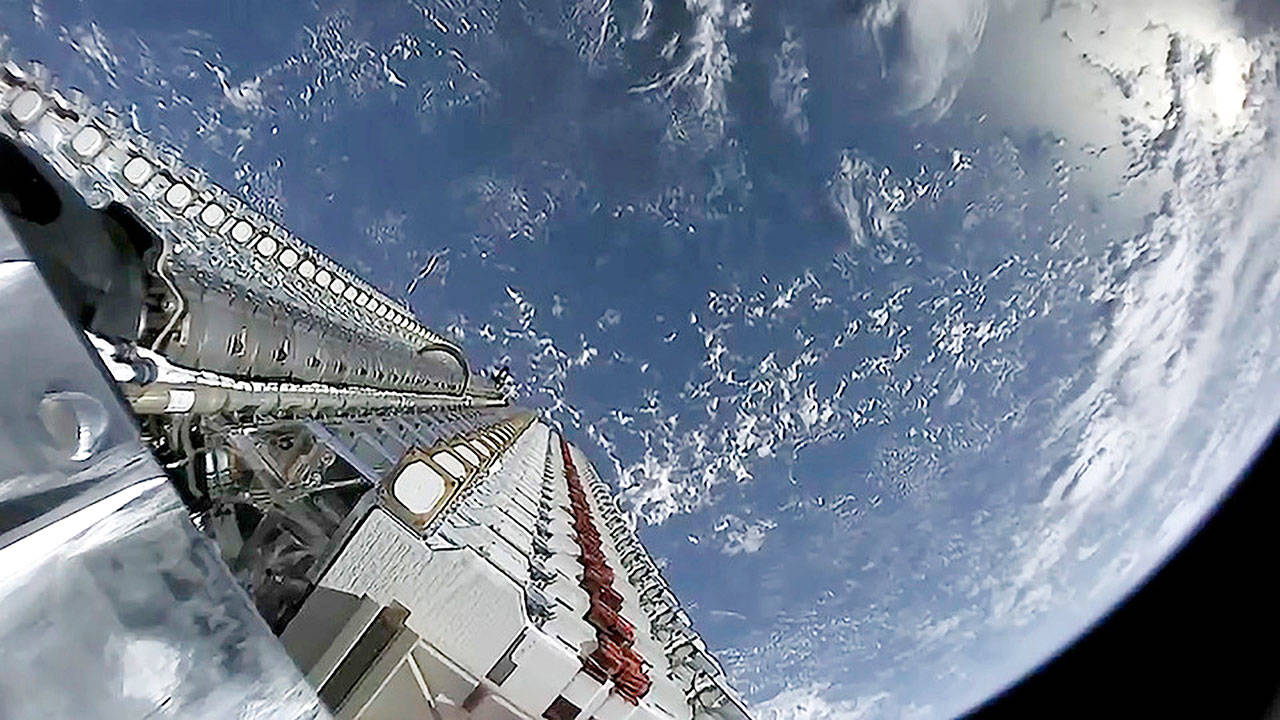ORLANDO, Fla. — They were seen sparkling across the skies of Montana right around Christmas: a tidy row of lights that some mistook to be UFOs. The glowing celestial train has been spotted in California, Texas, in the Netherlands and even Chile.
And it has astronomers worried.
Because the twinkling lights are not stars, planets or the faint objects hunted by observatories. They’re satellites, the first 120 in a constellation that could one day number in the tens of thousands if everything goes as planned for SpaceX.
Elon Musk’s rocket company made its entrance into the telecommunications field this year with the first two launches — each with 60 satellites — of Starlink, satellites that endeavor to blanket the globe in high-speed Internet connectivity.
The satellites have to be close to the planet, in low-Earth orbit, to provide a reliable, quick connection — unlike typical geostationary satellites that orbit the planet thousands of miles from the surface and that appear to be in a fixed spot. And there need to be thousands of them to create easy Internet accessibility even in the most remote areas of the globe.
So far, SpaceX has received approval to launch about 12,000 Starlink satellites.
That has astronomers concerned the satellites will interfere with their data calculations and pollute the night sky with artificial stars.
“What caught everybody off guard was just how bright the initial launch was. It was pretty dramatic,” said Jeffrey Hall, the director of the Lowell Observatory in Flagstaff, Arizona.
Hall, who is also a member of the American Astronomical Society, is among a group of scientists who have been working with SpaceX for the past six months to find a solution to the Starlink dilemma.
A launch planned for Friday from the Space Coast will test a possible solution. SpaceX will experiment with a non-reflective coating on the bottom of one satellite in its next batch of 60, scheduled to lift off from launch complex 40 at Cape Canaveral Air Force Station at 11:20 p.m.
The Astronomical Society has had numerous conversations with SpaceX since the first Starlink launch, on May 23, to discuss how to make the satellites less intrusive. Even now, at their operating altitude of about 550 kilometers, they are still right on the edge of visibility to the unaided eye.
But for research-grade telescopes? They’re “ferociously bright,” Hall said. That means they’re getting in the way of data collection, with the streaks of light ruining the scientific quality of images.
In early December, SpaceX President and chief operating officer Gwynne Shotwell said the company didn’t anticipate the problem but is determined to correct it, according to a report in SpaceNews.
“We want to make sure we do the right thing to make sure little kids can look through their telescope,” Shotwell said. “Astronomy is one of the few things that gets little kids excited about space.”
SpaceX isn’t yet sure if the coating will work without affecting the performance of the satellite.
“It’ll be some trial and error, but we’ll fix it,” Shotwell said.
The Federal Communications Commission recently approved SpaceX to operate its satellites across 72 lanes around the Earth, instead of 24. The change could allow SpaceX to reach full coverage of the United States sooner.
The company is also seeking approval to one day operate an additional 30,000 satellites.
That has Hall and other members of the astronomical community looking toward the future. SpaceX’s constellation is expected to be colossal, but it won’t be alone. Satellite manufacturer OneWeb, which has a factory near Kennedy Space Center, has said it has plans for launches of 30 satellites each, and Amazon has also applied to launch its own constellation of more than 3,000 satellites.
That would multiply the current number of satellites on orbit, about 2,000, a few times over.
“If you consider multiple operators with fleets of 10,000 or 12,000 satellites, suddenly you have a radically transformed sky,” Hall said.
And while the effort by SpaceX is “laudable,” he said, to bring high-speed Internet to the entire globe, it comes with consequences at a time when the privatization of space is really finding its footing and when the rules have not yet been firmed up.
“It’s kind of (the) Wild West up there right now,” Hall said.


